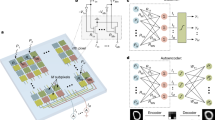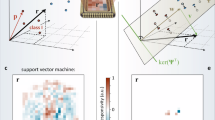Abstract
Optical imaging is commonly used for both scientific and technological applications across industry and academia. In image sensing, a measurement, such as of an object’s position or contour, is performed by computational analysis of a digitized image. An emerging image-sensing paradigm relies on optical systems that—instead of performing imaging—act as encoders that optically compress images into low-dimensional spaces by extracting salient features; however, the performance of these encoders is typically limited by their linearity. Here we report a nonlinear, multilayer optical neural network (ONN) encoder for image sensing based on a commercial image intensifier as an optical-to-optical nonlinear activation function. This nonlinear ONN outperforms similarly sized linear optical encoders across several representative tasks, including machine-vision benchmarks, flow-cytometry image classification and identification of objects in a three-dimensionally printed real scene. For machine-vision tasks, especially those featuring incoherent broadband illumination, our concept allows for a considerable reduction in the requirement of camera resolution and electronic post-processing complexity. In general, image pre-processing with ONNs should enable image-sensing applications that operate accurately with fewer pixels, fewer photons, higher throughput and lower latency.
This is a preview of subscription content, access via your institution
Access options
Access Nature and 54 other Nature Portfolio journals
Get Nature+, our best-value online-access subscription
$29.99 / 30 days
cancel any time
Subscribe to this journal
Receive 12 print issues and online access
$209.00 per year
only $17.42 per issue
Buy this article
- Purchase on Springer Link
- Instant access to full article PDF
Prices may be subject to local taxes which are calculated during checkout




Similar content being viewed by others
Data availability
The demonstration data for data gathering, as well as training data for the all-optical/digital neural networks, are available at https://github.com/mcmahon-lab/Image-sensing-with-multilayer-nonlinear-optical-neural-networks.
Code availability
All of the data generated, and code used, in this work are available at https://doi.org/10.5281/zenodo.6888985.
References
Duarte, M. F. et al. Single-pixel imaging via compressive sampling. IEEE Signal Process. Mag. 25, 83–91 (2008).
Sterling, P. Principles of Neural Design (MIT Press, 2015).
Gibson, G. M., Johnson, S. D. & Padgett, M. J. Single-pixel imaging 12 years on: a review. Opt. Express 28, 28190–28208 (2020).
Chang, J., Sitzmann, V., Dun, X., Heidrich, W. & Wetzstein, G. Hybrid optical-electronic convolutional neural networks with optimized diffractive optics for image classification. Sci. Rep. 8, 1–10 (2018).
Martel, J. N. P., Mueller, L. K., Carey, S. J., Dudek, P. & Wetzstein, G. Neural sensors: learning pixel exposures for HDR imaging and video compressive sensing with programmable sensors. IEEE Trans. Pattern Anal. Mach. Intell. 42, 1642–1653 (2020).
Wetzstein, G. et al. Inference in artificial intelligence with deep optics and photonics. Nature 588, 39–47 (2020).
Mennel, L. et al. Ultrafast machine vision with 2D material neural network image sensors. Nature 579, 62–66 (2020).
Pad, P. et al. Efficient neural vision systems based on convolutional image acquisition. In Proc. IEEE/CVF Conference on Computer Vision and Pattern Recognition 12285–12294 (IEEE, 2020).
Zheng, H. et al. Meta-optic accelerators for object classifiers. Sci. Adv. 8, eabo6410 (2022).
Matic, R. M. & Goodman, J. W. Comparison of optical predetection processing and postdetection linear processing for partially coherent image estimation. J. Opt. Soc. Am. A 6, 213–228 (1989).
Kubala, K., Dowski, E. & Cathey, W. T. Reducing complexity in computational imaging systems. Opt. Express 11, 2102–2108 (2003).
Stork, D. G. & Robinson, M. D. Theoretical foundations for joint digital-optical analysis of electro-optical imaging systems. Appl. Opt. 47, B64–B75 (2008).
Sitzmann, V. et al. End-to-end optimization of optics and image processing for achromatic extended depth of field and super-resolution imaging. ACM Trans. Graph. 37, 1–13 (2018).
Colburn, S., Chu, Y., Shilzerman, E. & Majumdar, A. Optical frontend for a convolutional neural network. Appl. Optics 58, 3179–3186 (2019).
Kim, K., Konda, P. C., Cooke, C. L., Appel, R. & Horstmeyer, R. Multi-element microscope optimization by a learned sensing network with composite physical layers. Opt. Lett. 45, 5684–5687 (2020).
Markley, E., Liu, F. L., Kellman, M., Antipa, N. & Waller, L. Physics-based learned diffuser for single-shot 3D imaging. In NeurIPS 2021 Workshop on Deep Learning and Inverse Problems (NeurIPS, 2021).
Vargas, E., Martel, J. N. P., Wetzstein, G. & Arguello, H. Time-multiplexed coded aperture imaging: learned coded aperture and pixel exposures for compressive imaging systems. In Proc. IEEE/CVF International Conference on Computer Vision 2692–2702 (IEEE, 2021).
Liutkus, A. et al. Imaging with nature: compressive imaging using a multiply scattering medium. Sci. Rep. 4, 1–7 (2014).
Li, J. et al. Spectrally encoded single-pixel machine vision using diffractive networks. Sci. Adv. 7, eabd7690 (2021).
Asif, M. S., Ayremlou, A., Sankaranarayanan, A., Veeraraghavan, A. & Baraniuk, R. G. Flatcam: thin, lensless cameras using coded aperture and computation. IEEE Trans. Comput. Imaging 3, 384–397 (2016).
Baek, S.-H. et al. Single-shot hyperspectral-depth imaging with learned diffractive optics. In Proc. IEEE/CVF International Conference on Computer Vision 2651–2660 (IEEE, 2021).
Sinha, A., Lee, J., Li, S. & Barbastathis, G. Lensless computational imaging through deep learning. Optica 4, 1117–1125 (2017).
Brady, D. J. et al. Smart cameras. Preprint at https://arxiv.org/abs/2002.04705 (2020).
Burt, P. J. Smart sensing within a pyramid vision machine. Proc. IEEE 76, 1006–1015 (1988).
Zhou, F. & Chai, Y. Near-sensor and in-sensor computing. Nat. Electron. 3, 664–671 (2020).
Marciniak, C. D. et al. Optimal metrology with programmable quantum sensors. Nature 603, 604–609 (2022).
Ballard, Z., Brown, C., Madni, A. M. & Ozcan, A. Machine learning and computation-enabled intelligent sensor design. Nat. Mach. Intell. 3, 556–565 (2021).
Shastri, B. J. et al. Photonics for artificial intelligence and neuromorphic computing. Nat. Photon. 15, 102–114 (2021).
Li, H.-Y. S., Qiao, Y. & Psaltis, D. Optical network for real-time face recognition. Appl. Opt. 32, 5026–5035 (1993).
Lin, H. W., Tegmark, M. & Rolnick, D. Why does deep and cheap learning work so well? J. Stat. Phys. 168, 1223–1247 (2017).
Wagner, K. & Psaltis, D. Multilayer optical learning networks. Appl. Opt. 26, 5061–5076 (1987).
Zuo, Y. et al. All-optical neural network with nonlinear activation functions. Optica 6, 1132–1137 (2019).
Fard, M. M. P. et al. Experimental realization of arbitrary activation functions for optical neural networks. Opt. Express 28, 12138–12148 (2020).
Ryou, A. et al. Free-space optical neural network based on thermal atomic nonlinearity. Photon. Res. 9, B128–B134 (2021).
Feldmann, J., Youngblood, N., Wright, C. D., Bhaskaran, H. & Pernice, W. H. All-optical spiking neurosynaptic networks with self-learning capabilities. Nature 569, 208–214 (2019).
Ashtiani, F., Geers, A. J. & Aflatouni, F. An on-chip photonic deep neural network for image classification. Nature 607, 501–506 (2022).
Zhou, T. et al. Large-scale neuromorphic optoelectronic computing with a reconfigurable diffractive processing unit. Nat. Photon. 15, 367–373 (2021).
Bernstein, L. et al. Single-shot optical neural network. Preprint at https://arxiv.org/abs/2205.09103 (2022).
Wang, T. et al. An optical neural network using less than 1 photon per multiplication. Nat. Commun. 13, 1–8 (2022).
Zemel, J. N. Sensors V 6—Optical Sensors—A Comprehensive Survey (John Wiley & Sons, 1991).
Jongejan, J., Rowley, H., Kawashima, T., Kim, J. & Fox-Gieg, N. The Quick, Draw! AI Experiment https://quickdraw.withgoogle.com/ (2016).
Schraivogel, D. et al. High-speed fluorescence image–enabled cell sorting. Science 375, 315–320 (2022).
Li, Y. et al. Deep cytometry: deep learning with real-time inference in cell sorting and flow cytometry. Sci. Rep. 9, 1–12 (2019).
Lee, K. C. M., Guck, J., Goda, K. & Tsia, K. K. Toward deep biophysical cytometry: prospects and challenges. Trends Biotechnol. 39, 1249–1262 (2021).
Hinton, G. E. & Salakhutdinov, R. R. Reducing the dimensionality of data with neural networks. Science 313, 504–507 (2006).
He, K., Zhang, X., Ren, S. & Sun, J. Deep residual learning for image recognition. In Proc. IEEE Conference on Computer Vision and Pattern Recognition 770–778 (IEEE, 2016).
Li, G. H.et al. All-optical ultrafast ReLU function for energy-efficient nanophotonic deep learning. Nanophotonics https://doi.org/10.1515/nanoph-2022-0137 (2022).
Guo, Q. et al. Femtojoule femtosecond all-optical switching in lithium niobate nanophotonics. Nat. Photon. 16, 625–631 (2022).
Nahmias, M. A., Shastri, B. J., Tait, A. N. & Prucnal, P. R. A leaky integrate-and-fire laser neuron for ultrafast cognitive computing. IEEE J. Sel. Top. Quantum Electron. 19, 1–12 (2013).
Mirek, R. et al. Neural networks based on ultrafast time-delayed effects in exciton polaritons. Phys. Rev. Appl. 17, 054037 (2022).
Bandyopadhyay, S. et al. Single chip photonic deep neural network with accelerated training. Preprint at https://arxiv.org/abs/2208.01623 (2022).
Xu, X. et al. 11 TOPS photonic convolutional accelerator for optical neural networks. Nature 589, 44–51 (2021).
Makarenko, M. et al. Real-time hyperspectral imaging in hardware via trained metasurface encoders. In Proc. IEEE/CVF Conference on Computer Vision and Pattern Recognition 12692–12702 (IEEE, 2022); https://doi.org/10.1109/CVPR52688.2022.01236
Loshchilov, I. & Hutter, F. Decoupled weight decay regularization. In 7th International Conference on Learning Representations (ICLR, 2019).
Akiba, T., Sano, S., Yanase, T., Ohta, T. & Koyama, M. Optuna: a next-generation hyperparameter optimization framework. In Proc. 25th ACM SIGKDD International Conference on Knowledge Discovery and Data Mining 2623–2631 (ACM, 2019).
Heuser, T. et al. Developing a photonic hardware platform for brain-inspired computing based on 5 × 5 VCSEL arrays. J. Phys. Photon. 2, 44002 (2020).
Narayan, A., Berger, B. & Cho, H. Assessing single-cell transcriptomic variability through density-preserving data visualization. Nat. Biotechnol. 39, 765–774 (2021).
Acknowledgements
We wish to thank NTT Research for their financial and technical support (to T.W., L.G.W., S.-Y.M., T.O. and P.L.M.). Portions of this work were supported by the National Science Foundation (award no. CCF-1918549 to T.W., M.M. Stein and P.L.M.), a Kavli Institute at Cornell instrumentation grant (to T.W. and P.L.M.), and a David and Lucile Packard Foundation Fellowship (to P.L.M.). P.L.M. acknowledges membership of the CIFAR Quantum Information Science Program as an Azrieli Global Scholar. T.W. acknowledges the partial support from Schmidt Futures via an Eric and Wendy Schmidt AI in Science Postdoctoral Fellowship to Cornell University. We acknowledge helpful discussions with A. Senanian, B. Malia, F. Presutti, V. Kremenetski, S. Prabhu, A. Barth, R. Oliver, and D. Schraivogel. We also acknowledge S. Sohoni for help with figure design.
Author information
Authors and Affiliations
Contributions
T.W., L.G.W., M.M. Sohoni and P.L.M. conceived the project and designed the experiments. M.M. Sohoni and T.W. built and performed the experiments on the nonlinear and linear ONN encoders, and analysed the data. T.W. performed the extended cell-organelle simulations. M.M. Stein performed the neural architecture search for QuickDraw reconstruction. S-Y.M. and T.O. aided in simulations of deep optical encoders. M.G.A. assisted with 3D-scene modelling. L.G.W., T.W., M.M. Sohoni and P.L.M. wrote the manuscript. P.L.M. and L.G.W. supervised the project.
Corresponding authors
Ethics declarations
Competing interests
T.W., M.M. Sohoni, L.G.W. and P.L.M. are listed as inventors on a US provisional patent application (serial no. 63/392,042) on nonlinear optical neural network pre-processors for imaging and image sensing. The other authors declare no competing interests.
Peer review
Peer review information
Nature Photonics thanks Jacques Carolan and the other, anonymous, reviewer(s) for their contribution to the peer review of this work.
Additional information
Publisher’s note Springer Nature remains neutral with regard to jurisdictional claims in published maps and institutional affiliations.
Supplementary information
Supplementary Information
Supplementary Figs. 1–29, Sections 1–3 and Tables 1–11.
Rights and permissions
Springer Nature or its licensor (e.g. a society or other partner) holds exclusive rights to this article under a publishing agreement with the author(s) or other rightsholder(s); author self-archiving of the accepted manuscript version of this article is solely governed by the terms of such publishing agreement and applicable law.
About this article
Cite this article
Wang, T., Sohoni, M.M., Wright, L.G. et al. Image sensing with multilayer nonlinear optical neural networks. Nat. Photon. 17, 408–415 (2023). https://doi.org/10.1038/s41566-023-01170-8
Received:
Accepted:
Published:
Issue Date:
DOI: https://doi.org/10.1038/s41566-023-01170-8
This article is cited by
-
Fiber optic computing using distributed feedback
Communications Physics (2024)
-
Analog spatiotemporal feature extraction for cognitive radio-frequency sensing with integrated photonics
Light: Science & Applications (2024)
-
Differential perovskite hemispherical photodetector for intelligent imaging and location tracking
Nature Communications (2024)
-
All-optical image denoising using a diffractive visual processor
Light: Science & Applications (2024)
-
The physics of optical computing
Nature Reviews Physics (2023)



